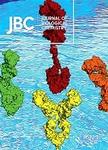版权所有:内蒙古大学图书馆 技术提供:维普资讯• 智图
内蒙古自治区呼和浩特市赛罕区大学西街235号 邮编: 010021

作者机构:Vancouver Gen Hosp Prostate Ctr Vancouver BC Canada
出 版 物:《JOURNAL OF BIOLOGICAL CHEMISTRY》 (生物化学杂志)
年 卷 期:2001年第276卷第4期
页 面:2943-2952页
核心收录:
学科分类:0710[理学-生物学] 071010[理学-生物化学与分子生物学] 07[理学]
主 题:别构调节 雄激素结合蛋白质/遗传学 碱基序列 结合部位/遗传学 分子序列数据 诱变 定点 启动区(遗传学) 前列腺特异抗原/遗传学 蛋白质结合 受体 雄激素/代谢 反应元件 硫酸酯类/药理学 动物 大鼠
摘 要:Genes uniquely regulated by the androgen receptor (AR) typically contain multiple androgen response elements (AREs) that in isolation are of low DNA binding affinity and transcriptional activity. However, specific combinations of AREs in their native promoter context result in highly cooperative DNA binding by AR and high levels of transcriptional activation. We demonstrate that the natural androgen-regulated promoters of prostate specific antigen and probasin contain two classes of AREs dictated by their primary nucleotide sequence that function to mediate cooperativity, Class I AR-binding sites display conventional guanine contacts. Class II AR-binding sites have distinctive atypical sequence features and, upon binding to AR, the DNA structure is dramatically altered through allosteric interactions with the receptor. Class II sites stabilize AR binding to adjacent class I sites and result in synergistic transcriptional activity and increased hormone sensitivity. We have determined that the specific nucleotide variation within the AR binding sites dictate differential functions to the receptor, We have identified the role of individual nucleotides within class II sites and predicted consensus sequences for class I and II sites. Our data suggest that this may be a universal mechanism by which AR achieved unique regulation of target genes through complex allosteric interactions dictated by primary binding sequences.